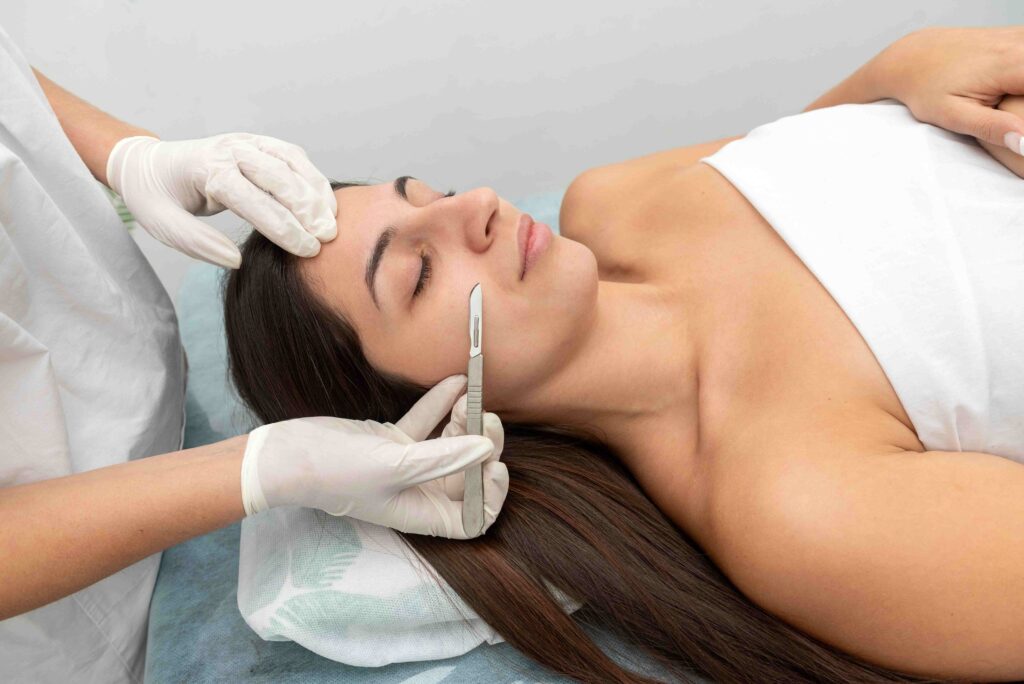The Benefits of Dermaplaning
Dermaplaning is a popular treatment that offers a range of benefits, including skin brightening, improvement in acne scars, and reduction in fine lines.
Instant Skin Brightening
Dermaplaning can promise immediate results, providing instantly smoother and brighter skin benefits even after just one session. This treatment effectively removes the top layer of dead skin cells and peach fuzz, leaving the skin looking radiant. Those who have opted for dermaplaning often note the visible enhancement in their complexion and an overall glow that lasts.
Appearance of Acne Scars
Dermaplaning is a minimally invasive procedure that shaves away the top layers of the skin, helping reduce the appearance of acne scars or pitted skin. By exfoliating the top layer, dermaplaning promotes cellular turnover, which gradually diminishes the visibility of acne scars. Combining this treatment with other procedures like microneedling can further enhance the results, offering even more refined skin texture.
Reduction of Fine Lines
Dermaplaning reveals newer, undamaged skin, making it an effective treatment for reducing the appearance of fine lines. By smoothing out the skin’s surface, dermaplaning helps in minimizing the visibility of age lines, contributing to a more youthful appearance. Integrating this technique with chemical peels or dermal fillers can provide comprehensive anti-aging benefits.
The benefits of dermaplaning extend beyond just the visible improvements; it also enhances the effectiveness of skincare products by allowing them to penetrate deeper into the skin. This makes it an excellent addition to any skincare routine, particularly when paired with treatments like custom facials or red light therapy.
| Benefit | Description |
|---|---|
| Skin Brightening | Radiant complexion with immediate results |
| Acne Scars Improvement | Reduces visibility of scars and pitted skin |
| Fine Lines Reduction | Reveals newer skin, smooths age lines |
Explore more on how dermaplaning can complement other treatments by visiting our sections on Microneedling and Chemical Peels. For a personalized skincare routine, consider scheduling a consultation with our experts.
Dermaplaning Procedure
Safe for Pregnant Women
Dermaplaning is considered safe for pregnant women as it is a simple mechanical exfoliation technique that does not involve the use of acids or chemicals. This means there is no risk of harmful substances being absorbed into the bloodstream, making it a suitable option during pregnancy. However, caution should be exercised regarding the use of any topical products post-treatment. The procedure should only be conducted on healthy, unblemished skin to avoid any complications.
Minimally Invasive Treatment
Dermaplaning is a minimally invasive procedure that involves using a precise, surgical scalpel to gently shave away the top layers of the skin. This technique helps in reducing the appearance of acne scars and other skin imperfections while also removing vellus hair, commonly known as peach fuzz. By eliminating dead skin cells, dermaplaning reveals a smoother and younger-looking surface. The effects, however, are temporary and do not prevent the aging process.
Recovery Process
The recovery process after dermaplaning is straightforward and quick, reflecting the non-invasive nature of the treatment. While there may be some minor redness immediately after the procedure, it typically subsides within a few hours. Patients are advised to avoid direct sunlight and use sunscreen to protect the newly exposed skin. Applying a hydrating moisturizer can also help soothe the skin and maintain its smooth texture.
| Post-Treatment Care | Key Recommendations |
|---|---|
| Sun Protection | Use sunscreen to shield your skin from UV rays |
| Hydration | Apply a hydrating moisturizer to maintain skin moisture |
| Avoid Harsh Products | Refrain from using abrasive scrubs or strong acids for at least a week |
For further information on protecting your skin post-treatment and additional skincare tips, visit our other resources such as custom facials, chemical peels, or red light therapy. Taking proper care post-treatment can ensure your skin stays radiant and healthy.
Dermaplaning and Hair Removal
Dermaplaning offers various benefits beyond just exfoliation. One of the key advantages of this procedure is its effectiveness in hair removal. In this section, we explore how dermaplaning facilitates both exfoliation and hair removal, debunk common myths, and address skin irritation considerations.
Exfoliation and Hair Removal
Dermaplaning stands out from other hair removal methods due to its dual-action benefits: it removes unwanted hair and exfoliates the skin simultaneously. Unlike shaving, which only cuts hair at the skin’s surface, dermaplaning involves scraping off dead skin cells along with peach fuzz using a scalpel or specialized razor blade. This combination results in a smoother, more radiant skin appearance.
| Method | Exfoliation | Hair Removal | Tool Used |
|---|---|---|---|
| Shaving | No | Yes | Razor blade |
| Dermaplaning | Yes | Yes | Scalpel/Razor blade |
Myths Debunked
A common myth surrounding dermaplaning is that it will cause hair to grow back thicker or darker. However, this is not true. The procedure merely removes the vellus hair, also known as peach fuzz, and does not affect the hair follicle or growth pattern. The hair will grow back at the same rate and texture as before, making dermaplaning a safe and effective method for maintaining smooth skin.
Another misconception is that dermaplaning is the same as other skin resurfacing treatments like dermabrasion or microdermabrasion. Unlike dermaplaning, which is done with a scalpel, dermabrasion is a surgical procedure, and microdermabrasion uses an exfoliating blade to sand away the skin (Cleveland Clinic).
Skin Irritation Considerations
While dermaplaning is generally considered safe and minimally invasive, it can cause mild skin irritation, especially for individuals with sensitive skin. Redness, dryness, and a tingling sensation are common side effects that typically subside within a few hours to a couple of days. It is advisable to avoid direct sun exposure and use sunscreen after the procedure to protect the newly exposed skin layers.
For those concerned about potential skin irritation, consulting with a professional can provide a tailored approach to minimize these risks. Professionals can recommend appropriate aftercare products and routines to ensure optimal results and comfort.
For more information on combining dermaplaning with other treatments like custom facials and chemical peels, visit our related sections.
By understanding these aspects of dermaplaning, individuals can make informed decisions about incorporating this beneficial procedure into their skincare routine.
Combining Dermaplaning with Other Treatments
Combining dermaplaning with other treatments can significantly elevate your skincare regimen. These combinations provide enhanced results and address multiple skin concerns simultaneously.
HydraFacial and Microneedling
Combining dermaplaning with a HydraFacial treatment or microneedling can provide synergistic benefits. Dermaplaning removes the outer layer of dead skin cells and peach fuzz, creating a smooth canvas for subsequent treatments. This allows the HydraFacial or microneedling to penetrate deeper and work more effectively. Combining these treatments can result in firmer, smoother, and more youthful-looking skin.
Benefits of HydraFacial and Microneedling with Dermaplaning:
- Enhanced removal of dead skin cells
- Improved absorption of serums and nutrients
- Boosted collagen production
- Reduced appearance of fine lines and wrinkles
Chemical Peel Add-On
Pairing dermaplaning with a chemical peel can be transformative. Dermaplaning preps the skin by removing dead cells and hair, allowing the active ingredients in the chemical peel to penetrate more deeply and evenly. This results in a more thorough and effective treatment.
| Treatment Combination | Benefits |
|---|---|
| Dermaplaning + Chemical Peel | Deeper penetration of active ingredients |
| Enhanced exfoliation and skin renewal | |
| Brighter and more even skin tone |
Enhanced Collagen Production
Combining dermaplaning with treatments that stimulate collagen production, such as microneedling or enzyme treatments, can lead to impressive results. Dermaplaning removes surface barriers, enabling these treatments to reach deeper layers of the skin, which enhances their effectiveness.
Enhanced Collagen Production Benefits:
- Firmer skin texture
- Reduced appearance of scars and hyperpigmentation
- Increased skin elasticity
- Youthful, glowing complexion
By integrating dermaplaning with other treatments like HydraFacial, microneedling, or chemical peels, clients can achieve optimal skin health and maintain a radiant complexion. For more treatments that can boost your skincare routine, check out our articles on custom facials, dermal fillers, and dysport botox.
Risks and Considerations
Not Suitable Candidates
Dermaplaning isn’t recommended for individuals with inflammatory skin conditions such as acne or for those taking isotretinoin, a prescription medication for severe acne. It should also not be performed on active acne as it can spread bacteria and cause more breakouts. The treatment is not suitable for individuals with sensitive skin, a recent sunburn, or those who have taken Accutane or isotretinoin within the last six months.
Potential Side Effects
Potential side effects of dermaplaning include breakouts, irritation, dryness, and minor cuts. The skin may be left red, discolored, or itchy for one to two days post-treatment. Temporary dryness and minor cuts or grazes can occur, especially in cases where the skin texture is uneven. Additionally, the skin may be red, swollen, and slightly tender. Over-the-counter pain medication may be recommended for discomfort. If the swelling persists longer than a week or worsens, it’s advised to contact a healthcare provider (Cleveland Clinic).
| Potential Side Effects | Duration |
|---|---|
| Redness | 1-2 days |
| Swelling | Up to 1 week |
| Dryness | Temporary |
| Minor Cuts | Temporary |
| Itchiness | 1-2 days |
Seeking Professional Treatment
Dermaplaning should always be conducted by a trained professional, such as a plastic surgeon, dermatologist, or licensed cosmetologist, using a special instrument called a dermatome. The procedure does not require general anesthesia, and a numbing cream or spray may be applied beforehand. Proper preparation and skin care are crucial for achieving the best results and minimizing risks. Avoid performing the treatment at home and ensure to thoroughly research the provider to prevent dermaplaning horror stories.
By choosing professional treatment, the skin is gently exfoliated by shaving off the top layers, and afterward, a soothing gel or ointment is applied to reduce redness, swelling, or irritation. For more on advanced skincare treatments, explore custom facials and chemical peels.
Always consult with a professional to determine if dermaplaning is the right choice for your skin type and to discuss any potential risks or concerns. Properly evaluating these factors ensures a safe and effective dermaplaning experience.
Pre-Treatment Preparations
Proper preparation for dermaplaning is crucial for achieving the best results. Here’s a simplified guide to help you get ready for the treatment:
- Consultation: Schedule a consultation with a qualified provider to discuss your skin type and goals.
- Skin Condition: Ensure your skin is in optimal condition by avoiding other exfoliating treatments at least a week prior.
- Avoid Sun Exposure: Minimize sun exposure and use sunscreen to protect your skin.
- Numbing Cream: A numbing cream may be applied before the procedure for added comfort (Cleveland Clinic).
Dermaplaning can be effectively combined with other treatments for enhanced results. Consider adding a HydraFacial or Chemical Peel, as recommended by CAS MediSpa.
Recommended Skin Care Routine
Post-treatment care is essential to maintain the benefits of dermaplaning and protect your skin:
- Moisturize: Keep your skin hydrated with a gentle moisturizer.
- Sunscreen: Apply a broad-spectrum sunscreen daily to protect your newly revealed skin from UV damage.
- Gentle Products: Use mild, non-irritating skincare products to avoid sensitivity.
Additional treatments like custom facials and red light therapy can also boost your skincare regimen, complementing the effects of dermaplaning.
For more detailed information on post-treatment skincare. Their expert guidance ensures clients achieve and maintain the radiant skin they desire.








